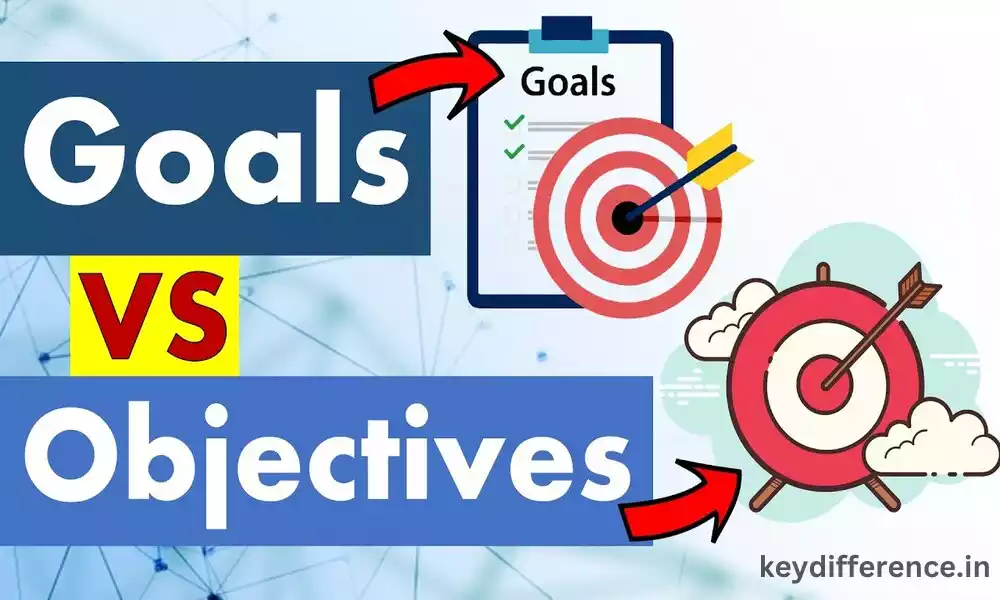Introduction
Setting clear objectives and goals, both personal and professional, is integral to success. While “goal” and “objective” may often be used interchangeably, they each serve different functions when planning for success and measuring progress.Understanding the distinctions between goals and objectives is essential to effective planning, resource allocation, and progress measurement.
By understanding their various features we can gain an understanding of why both goals and objectives should be set simultaneously and how they complement one another to drive individuals and organizations toward their desired results.
We will delve into the definitions, characteristics, and differences between goals and objectives; illustrate their benefits; provide illustrative examples to demonstrate these ideas; and stress their necessity when setting clear goals and objectives.We should have gained an in-depth knowledge of these concepts to implement them efficiently in our goal-setting and planning processes.
Definition of goal
Goals can be defined as broad and abstract statements that outline desired results that individuals, organizations, or systems seek to attain.
Goals represent an endpoint that guide our actions and decision-making and should serve as our ultimate purpose or destination; goals often serve as motivation to work toward them long term; they act as guides that motivate individuals or groups towards reaching them – though often non-specific or time bound goals serve this function best.

Characteristics of Goals
Goals stand out from objectives with specific characteristics that distinguish them.
Here are the main qualities of goals:
Goals Are Broad and Overarching: Goals are intended to be broadly and overarching in scope, representing an organization or system’s larger purpose or desired result that they strive for.
Qualitative and Visionary Goals: Goals can often be expressed qualitatively, outlining desired states or impacts rather than specific quantifiable measures. Such goals provide direction while inspiring and motivating individuals or groups alike.
Long-Term Focus: Goals typically encompass long-term objectives that extend beyond immediate or short-term targets, outlining an ultimate destination or accomplishment that may take considerable effort, time, and resources to reach.
Goals Focus on Desired Outcomes: Goals emphasize desired results or outcomes rather than specific actions or tasks, creating a sense of direction and purpose to guide decision making and planning processes.
Goals Are Less Specific and Measurable: In contrast with objectives, goals tend to be less specific and measurable, providing a broader outlook without set criteria or metrics for evaluation. They provide general direction rather than specific steps or targets.
Understanding these characteristics of goals is vital to setting realistic and inspiring objectives that lead to their achievement. While goals provide the overall vision, objectives provide actionable steps and measurable targets necessary for reaching desired outcomes.
Broad and overarching
One of the hallmarks of goals is their broad and overarching nature, meaning they cover a wide variety of objectives, tasks and outcomes related to them. Instead of being overly detailed or focused on details alone, goals provide individuals, teams or organizations with direction at an overarching level.
Goals can cover many different areas and focuses. For instance, business goals could involve increasing market share – this may have an effect on marketing strategies, product development and customer service as well as impactful personal goals like exercising more or improving nutrition and self-care practices.
By setting broad goals, individuals and organizations can have greater flexibility when setting action steps to attain them, while still remaining open to adaptability in response to changing conditions or new opportunities. Setting large-scale goals also gives individuals and organizations a sense of purpose and direction guiding decision-making and efforts towards the desired results.
Goal setting requires setting broad yet specific goals that provide meaningful guidance. Setting overly vague or ambiguous goals may result in confusion and lack of implementation clarity, therefore striking a balance between broadness and specificity when formulating effective goals is vital to their effectiveness.
Qualitative and visionary
Goals differ from objectives in that they tend to be qualitative and visionary in nature, rather than specific numerical targets. Instead, goals focus on conveying desired states or impacts rather than specific numerical targets.
Goals typically take the form of qualitative statements that emphasize desired outcomes or quality instead of exact quantities or metrics.
For instance, your goal may include improving customer satisfaction or increasing employee engagement as examples of such goals; such statements reflect improvements without providing exact figures or percentages.
Goals should be visionary by providing an overarching vision or aspiration for the future, transcending any short-term objectives, and represent long-term paths individuals, teams, or organizations aspire to follow.
Goals provide individuals with a sense of purpose while encouraging them to work toward fulfilling larger ambitions or purposes. Being qualitative and visionary, goals provide the freedom to envision and articulate desired states without being limited by specific metrics or numbers.
This allows flexibility when determining actions and strategies to meet goals; goals also serve as guiding principles and sources of inspiration, aligning efforts towards one shared vision and motivating individuals towards meaningful results.
Goals serve as the qualitative vision, while objectives provide specific, measurable targets and actionable steps to meet those goals. Together, goals and objectives provide a powerful framework for planning and execution – driving progress and success along the way.
Less specific and measurable
One characteristic of goals is their often less precise and measurable nature compared to objectives. While objectives typically outline specific criteria and measurable targets, goals typically provide more of a broad and general outlook without specifying exact metrics or numbers.
They outline desired outcomes or directions and set an overarching vision for individuals, teams, or organizations. Goals serve to inspire and direct efforts rather than provide detailed instructions on how to reach them; hence they are often expressed qualitatively describing desired states such as desired impact or improvements without providing exact measurements of achievement.
Goals for businesses often set an overall aspiration or vision without offering specific targets or benchmarks to reach. An example would be “becoming an industry leader” or “establishing a strong brand presence”. Such goals help communicate an aspiration or vision without offering tangible benchmarks or targets to meet.
Goals may not be as tangible or quantifiable, yet they play a critical role in goal setting. Goals provide context and purpose, helping individuals or organizations prioritize efforts and make decisions aligned with desired results.
Objectives, on the other hand, should be defined as specific, measurable, attainable, relevant and time-bound targets that help realize goals. They provide actionable steps and milestones towards meeting them more broadly.
By setting less specific and qualitative goals in combination with more measurable objectives, individuals or organizations can achieve a balance between visionary direction and actionable implementation for successful goal attainment.
Definition of objective
Objectives can be defined as tangible targets or milestones set to support the achievement of a goal.
They should be specific and measurable in nature and provide clear criteria for evaluation and measurement – similar to goals but with quantified outcomes that provide stepping-stones or action steps towards larger goals that allow tracking progress, allocating resources efficiently, making informed decisions, as well as providing a path towards reaching desired outcomes more quickly.
Unlike goals, objectives tend to have short-term goals that provide clear pathways towards their fulfillment.

Characteristics of Objectives
Objectives possess distinct features that distinguish them from goals.
Here are the key characteristics of objectives:
Specific and Concrete: Objectives should be written so as to be both specific and concrete in nature, providing clear details of what must be accomplished. Specifically defining actions, tasks or outcomes needed in order to attain one goal.
Quantitative and Measurable: Objectives are more easily measured and quantifiable compared to goals. Measurable objectives offer an easy way of tracking performance and measuring success.
Short-Term Focus: Objectives are typically designed to be achieved within a relatively short timeframe and serve as short-term milestones that contribute to larger goals. By setting time-bound objectives, individuals or organizations can break down their goals into manageable steps that are actionable and can bring closer their goal of achievement.
Actions and Milestones: Objectives identify specific actions, tasks, or milestones that must be achieved to reach a goal. They serve as an action plan for individuals or teams on what must be completed when.
Goal Setting Strategies: Objectives Provide a Clear Path: Objectives act as building blocks towards reaching one’s desired outcomes by outlining all necessary actions or milestones that need to be met in order to reach them.
By including these characteristics in their objectives, individuals or organizations can develop an actionable plan for goal attainment.
Objectives provide specific targets, measurable criteria, and actionable steps necessary to turn broad goals into reality while tracking progress, allocating resources efficiently, and making informed decisions along the way.
Specific and concrete
An important characteristic of objectives is their specificity and concreteness, in contrast to goals which tend to be overarching and vague. Objectives provide clear and detailed information about what needs to be accomplished; outlining actions, tasks or outcomes necessary for making progress toward meeting a goal.
Specific: Objectives should be written so as to be clear and unmistakeable; they clearly outline what outcomes you want and leave no room for interpretation or confusion. Specific objectives address questions of who, what, when, where and how – for instance instead of setting an aim of improving customer service generally such as “reduc[ing average response times to customer inquiries to less than 24 hours].”
Concrete: Objectives that are concrete are those which can be seen, measured and observed – for instance a fitness goal could include running a 5k race under 25 minutes as an objective that provides clarity without leaving room for subjective interpretation. An example would be setting a target time of 25 minutes on your run!
By being specific and concrete, objectives provide clear directions for action. They help individuals or teams understand what needs to be accomplished while setting clear expectations of success. Furthermore, specific and concrete objectives facilitate effective communication as they leave no room for misinterpretation or confusion.
As objectives are specific and measurable, they allow individuals or organizations to monitor progress, evaluate performance and make necessary adjustments along the way. They serve as tangible milestones which can be marked off or measured – providing a sense of achievement while spurring further progression.Specific and concrete objectives play a pivotal role in goal attainment by providing clarity, focus, and an observable path toward achievement.
Quantitative and measurable
Objectives also feature important characteristics: they tend to be quantifiable and measurable. Unlike goals, which tend to be qualitative in nature, objectives contain specific metrics or criteria which allow individuals to assess progress towards reaching their objective or determine if it has been accomplished.
Quantitative: Objectives must include elements that can be expressed numerically and provide clear targets or benchmarks that can be measured objectively. Quantitative objectives provide clear tracking and comparison, helping individuals or organizations assess performance objectively while making data-driven decisions.
Quantitative goals could include increasing sales revenue by 10% in the next quarter or decreasing manufacturing defects to under 1% of total production, providing specific numerical targets which can be measured and evaluated.
Measurable: Objectives should be designed with measurement in mind, so progress and success can be objectively evaluated. Measurable objectives have well-established criteria or indicators that enable individuals or teams to track progress, evaluate performance, and determine if an objective has been accomplished.
Measurable objectives provide a straightforward method of tracking progress and making informed decisions based on results. By setting these measurable objectives, individuals or organizations can monitor their own performance and adapt accordingly.
Establishing measurable objectives creates accountability and provides a basis for evaluating success or identifying areas for improvement. They allow individuals or teams to measure progress towards their goals more easily, making adjustments as needed and moving more towards reaching them effectively.
By including quantitative and measurable elements in their objectives, individuals or organizations can easily track progress, measure success and make data-driven decisions to meet their goals.
Detail actions and milestones
Objectives provide an important roadmap or plan of action, outlining all necessary actions and milestones that need to be met in order to move closer towards reaching one’s goal.
Detail Actions: Objectives provide clarity and guidance to individuals or teams about what needs to be accomplished and how best to approach reaching a desired goal. By outlining specific actions or activities necessary for this outcome, objectives give individuals or teams more clarity about their specific task at hand and the appropriate way forward.
Specifically, if your goal is to launch a new product, some possible objectives for setting aside could include conducting market research, creating a product prototype, formulating marketing strategy and establishing distribution channels. Such activities provide a clear roadmap to execute the project and achieve your goal.
Milestones: Objectives may also include milestones as an integral component. Milestones are key checkpoints or achievements along the journey towards your ultimate goal and indicate progress made toward specific targets or deliverables.
Milestones can help individuals or teams track their progress and remain motivated as tangible evidence of progress is seen. They provide a sense of achievement while serving as markers towards an ultimate goal; milestones may be time-based, task-based or result-based depending on the nature of their objective.
If the goal is to launch a new website, milestones might include finishing the design phase, developing the website structure, integrating functionalities, and conducting user testing. These markers of progress allow tracking and evaluating project progress.
By outlining specific actions and milestones, objectives provide a practical roadmap to goal attainment. They break down large goals into more manageable steps that make tracking progress more manageable while allocating resources more efficiently as well as recognizing any necessary adjustments along the way.
Provide a clear path to achieve goals
Objectives offer individuals or organizations a tangible roadmap towards reaching their desired outcomes. Objectives provide this roadmap by outlining specific tasks or milestones which must be completed, offering a practical plan of action or roadmap. This ensures they have an organized approach towards meeting their desired outcomes.
Breaking an overall goal down into smaller, manageable objectives enables individuals or teams to identify specific steps required to progress towards it. Each objective represents an obtainable milestone that contributes to reaching the overall objective. This step-by-step approach offers a logical sequence of actions, leading individuals or organizations towards ultimate success.
Objectives provide a path that benefits us in various ways:
Focus and Direction: Objectives provide clarity and direction, aligning individual efforts towards specific outcomes. They allow individuals or teams to understand which priorities or tasks should take priority, eliminating confusion and providing an important sense of direction.
Prioritization: Objectives help individuals and organizations prioritize tasks based on their relevance to achieving an overall goal, as well as ensure resources are allocated effectively towards those objectives with the greatest impact in realizing those goals.
Progress Tracking: Objectives serve as milestones or checkpoints that enable individuals and teams to keep an eye on their progress, by monitoring completion of objectives they can assess how far they have come while making adjustments if deviations arise.
Motivation and Accountability: Having clear goals helps individuals or teams stay motivated and accountable. As each objective is completed step-by-step, individuals gain a sense of progress and accomplishment – this helps sustain motivation while pushing toward their end goal.
Decision-Making: Objectives provide a compass that makes decision-making processes simpler. When faced with choices or challenges, individuals or organizations can refer to their objectives to determine the best course of action that aligns with their overall goal.
Individuals or organizations can navigate their way toward goal attainment more effectively by setting clearly-outlined objectives that provide structure, focus and accountability – helping direct efforts toward specific actions and milestones required to realize desired results.
Comparison Table of Goal and Objective
Here’s a comparison table highlighting the key differences between goals and objectives:
| Aspect | Goals | Objectives |
|---|---|---|
| Scope and Focus | Broad and overarching | Specific and focused |
| Specificity | General and qualitative | Specific and quantitative |
| Timeframe | Long-term | Short-term |
| Measurability | Less measurable | Measurable and trackable |
| Relationship | Objectives contribute to achieving | Support the accomplishment of goals |
| Example | Increase market share | Launch a new marketing campaign to target a specific demographic |
| Example | Improve customer satisfaction | Reduce response time to customer inquiries by 50% |
This table summarizes the primary distinctions between goals and objectives. Goals have a broad and overarching focus, whereas objectives are specific and narrow in scope. Goals are generally qualitative, describing desired outcomes, while objectives are quantitative, providing measurable targets.
Goals are typically long-term, while objectives are short-term and actionable. Objectives are designed to support the accomplishment of goals, and they are more readily measurable and trackable.The examples provided illustrate the difference between a goal statement and its corresponding specific objective.
Progress tracking and evaluation
Progress monitoring and evaluation are integral parts of reaching goals and objectives. They entail monitoring the progress made toward desired outcomes, assessing whether targets have been met and making any necessary adjustments or improvements along the way, ultimately contributing to goal attainment.
Here is how progress tracking and evaluation aid in goal attainment:
Monitoring Progress: Progress tracking involves regularly tracking the advancement of an objective or goal to its desired state. Individuals or organizations can use progress tracking to keep an eye on completed tasks, actions or milestones as well as overall progress made towards their goal – this helps ensure efforts are on target with what was originally envisioned for success.
Assessing Performance: Evaluating performance involves measuring results against established objectives. It involves comparing actual progress made against desired or expected results. Evaluation may involve analyzing quantitative data, reviewing qualitative feedback, conducting surveys or assessments or other measurement tools as applicable.
Recognizing Successes and Challenges: Tracking progress helps identify both successes and challenges. Assessing their progress enables individuals or organizations to determine what has been working well and recognize successes while simultaneously pinpointing areas where progress has slowed or obstacles have emerged, providing proactive problem-solving measures and adjustments.
Making Informed Decisions: Tracking Progress and Evaluating Performance Provides Valuable Insights for Making Informant Decisions: Progress tracking and evaluation provide invaluable information for decision-making, including strategic choices, resource allocation decisions and plan modifications. By tracking real-time progress and outcomes observed it helps individuals or organizations make more informed decisions based on real time progress and outcomes observed.
Improving Performance: Progress tracking and evaluation provide a platform for continuous development. By tracking how far individuals or organizations have come, analyzing progress made, evaluating performance, identifying areas for improvement, refining strategies as needed, and taking corrective actions as required, tracking can foster a learning-oriented culture which supports iterative development toward reaching their goals.
Maintaining Accountability: Regular progress monitoring and evaluation helps maintain accountability. By measuring their progress towards their set objectives, individuals or teams can hold themselves responsible. Transparency helps ensure everyone remains committed to the goal while accepting responsibility for their contributions.
Progress tracking and evaluation provide the means to measure, analyze and optimize performance towards goals and objectives. They allow individuals and organizations to stay on course towards meeting goals by making data-driven decisions that can alter their approach as necessary in order to increase chances of goal attainment success.
Alignment of efforts and resources
Aligning efforts and resources is a critical element of effectively meeting goals and objectives. Aligning involves making sure actions, activities, and resources align toward achieving desired results.
Here’s how alignment contributes to goal attainment:
Align: Aligning efforts and resources with defined goals and objectives ensures that efforts and resources are allocated appropriately, eliminating distractions while channeling efforts directly towards activities that contribute to desired results. This clarity enables individuals or organizations to establish clear paths and purposes – eliminating them while making sure efforts contribute directly to desired results.
Efficient Resource Allocation: Aligning efforts and resources with specific objectives allows individuals or organizations to allocate their time, manpower, budget and other resources more efficiently and avoid waste or unnecessary expenditures on activities which don’t correspond with their goals. This ensures resources are utilized efficiently rather than wasted or spent in activities that don’t correspond with goals.
Synergy and Collaboration: Aligning team members or departments towards a common goal creates synergy and collaboration that results in more efficient goal attainment. When all are aligned towards this common vision, everyone shares an understanding of desired results while working collectively towards attaining them. By pooling collective talents, expertise, perspectives, and skillsets efficiently towards meeting one objective more quickly.
Minimizing Conflicted Priorities: Alignment can help minimize conflicted priorities. By clearly communicating goals and objectives to individuals or teams, individuals or teams can work towards them more easily by prioritizing tasks that contribute towards them and eliminating competing objectives that divert resources away from achieving the desired results.
Maximizing Impact: Alignment ensures that efforts and resources are focused on activities with the greatest impact for goal attainment. Individuals or organizations can align specific objectives with specific actions/initiatives that most likely drive progress toward desired results, increasing efficiency and effectiveness of efforts, which in turn increases chances of goal attainment success.
Aligning resources allows for adaptability and flexibility when allocating them, with individuals or organizations being able to make adjustments based on changing circumstances or new needs as progress is tracked and evaluated. Alignment provides a dynamic approach to resource allocation that ensures resources are utilized optimally with regards to meeting evolving goals and objectives.
Aligning efforts and resources with goals and objectives ensures an organized, focused, and collaborative approach to goal attainment. Aligning efforts with these objectives enables resource allocation optimization, reduced conflict resolution costs, maximize impactful outputs and adaptation for successful pursuit of desired results. Alignment is therefore one of the keys to successfully reaching goals and objectives effectively.
Motivation and accountability
Motivation and accountability play essential roles in meeting goals and reaching objectives. These interrelated elements help individuals or teams stay committed, take steps forward, and reach desired results.
Here’s how motivation and accountability contribute to goal attainment:
Goal Clarity: Set Goals and Aim for Achievement
Intrinsic and Extrinsic Factors: Motivation can come from both intrinsic (personal satisfaction, passion, sense of achievement) and extrinsic factors (rewards, recognition and incentives). Understanding what motivates individuals can help ensure sustained effort and enthusiasm towards reaching goals.
Milestones and Progress: Breaking goals into smaller milestones allows individuals or teams to experience a sense of progress and accomplishment, fuelling motivation with momentum that it is within reach of reaching the ultimate goal.
Accountability: Commitment and Responsibilty: Accountability fosters ownership and commitment to goals and objectives, creating a sense of ownership for individuals or teams being held responsible for their actions or outcomes and increasing likelihood that they’ll take responsibility and put forth effort toward realizing desired results.
Clear Expectations: Outlining roles, responsibilities and expectations clearly helps establish accountability. Once individuals understand what is expected of them and how their contributions contribute towards reaching an overall goal, they’re more likely to remain committed and take responsibility for their performance.
Measuring and Evaluating Progress: Measuring and Evaluating Progress is an integral component of accountability, helping individuals or teams track progress against objectives to assess themselves against progress targets, identify areas for improvement and take corrective measures if necessary.
Support and Feedback: A supportive environment which fosters open communication, collaboration, and learning can help motivate and hold individuals accountable towards reaching their goals. When individuals feel supported and inspired to achieve them they’re more likely to remain engaged and committed towards reaching them.
Constructive Feedback: Delivering constructive feedback helps individuals or teams understand their strengths, areas for development and necessary course corrections. Such feedback serves as a catalyst for growth and increased accountability by keeping individuals focused on their performance while taking steps to enhance its effectiveness.
Motivation and accountability are inextricably intertwined forces that mutually reinforce each other. A motivated individual or team is more likely to feel accountable for their actions and results, while accountability helps maintain motivation by providing a sense of responsibility and consequent consequences for performance.
Motivation and accountability when properly implemented will enable individuals or teams to stay focused, overcome challenges, and remain committed to their goals and objectives. They become adaptable and resilient – ultimately leading to a sense of success for themselves or the organization as a whole.
Conclusion
Goals and objectives are integral components to reaching desired outcomes, yet there are distinct distinctions between them. Goals serve as broad, overarching statements that define an organization’s overall direction and purpose while objectives provide specific, measurable, time-bound targets that provide a path towards reaching these goals.
Goals and objectives each have unique characteristics that distinguish them. Goals tend to be broad and expansive, providing qualitative guidance; in contrast, objectives tend to be specific, concrete and often quantitative in nature, outlining actionable steps and measurable milestones that outline achievable steps and milestones for progress. Goals define an overall vision while objectives break this down into manageable tasks with clear pathways towards progress.







